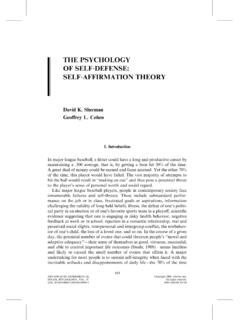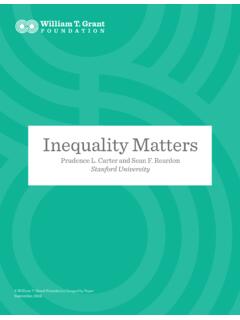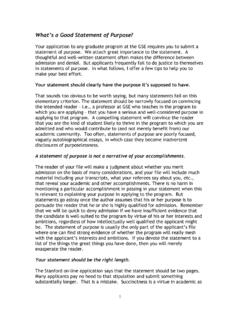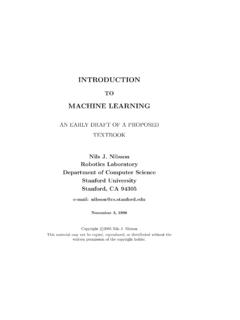Transcription of The Psychology of Change: Self-Affirmation and Social ...
1 PS65CH13-CohenARI31 October 201313:5 The Psychology of Change: Self-Affirmation and SocialPsychological InterventionGeoffrey L. Cohen1and David K. Sherman21 Graduate School of Education, Department of Psychology , and (by courtesy) Graduate Schoolof Business, stanford University, stanford , California 94305; email: of Psychological & Brain Sciences, University of California, Santa Barbara,California 93106; email: Rev. Psychol. 2014. 65:333 71 TheAnnual Review of Psychologyis online article s 2014 by Annual rights reservedKeywordshealth, intervention, relationships, Self-Affirmation , stereotype threatAbstractPeople have a basic need to maintain the integrity of the self, a global senseof personal adequacy. Events that threaten self-integrity arouse stress andself-protective defenses that can hamper performance and growth.
2 However,an intervention known as Self-Affirmation can curb these negative interventions typically have people write about core per-sonal values. The interventions bring about a more expansive view of theself and its resources, weakening the implications of a threat for personal in-tegrity. Timely affirmations have been shown to improve education, health,and relationship outcomes, with benefits that sometimes persist for monthsand years. Like other interventions and experiences, self-affirmations canhave lasting benefits when they touch off a cycle of adaptive potential, apositive feedback loop between the self-system and the Social system thatpropagates adaptive outcomes over time. The present review highlights bothconnections with other disciplines and lessons for a Social psychological un-derstanding of intervention and Rev.
3 Psychol. :333-371. Downloaded from stanford University - Main Campus - Lane Medical Library on 01/03/14. For personal use October 201313:5 Self-integrity:theperception of oneselfas morally andadaptively 334 The Pervasive Psychology of 335 Self-AffirmationTheory .. 336 WhatAre Self-Affirmations?.. 337 Understandingthe Effects of 339 Cycles of Adaptive Potential: How Social Psychological Processes Suchas Self-Affirmation Propagate Through Time .. 347 IntergroupConflict and 352 IMPLICATIONS,QUALIFICATIONS,ANDQUESTIONS .. 354 Moderatorsand Boundary 358 ConnectionsWith OtherResearch 362 INTRODUCTIONIn the 1940s, despite war shortages in finer meats and produce, many American homemakersrefused to purchase inferior but more abundant foods even when pressured with patriotic when Kurt Lewin (1997/1948) brought homemakers together in small groups to talk aboutobstacles to serving the recommended foods thus creating a new group norm around the desiredbehavior their purchase patterns changed.
4 In the Civil Rights era, prejudice was widespread,and opposition to equal rights proved tenacious in many quarters. But when Milton Rokeach (1973)threatened Americans conception of themselves as compassionate with a brief insinuation thatthey valued their own freedom more than the freedom of others their support for civil rightsstrengthened in a lasting many Social problems afflict society inequalities in education, health, and economicoutcomes; political polarization; and intergroup conflict. But these Social problems share a psy-chological commonality with the historical cases described above. The commonality is the notionthat barriers and catalysts to change can be identified and that Social psychological interventionscan bring about long-term review has two purposes. First it looks at threats to, and affirmations of, the self as barriersand catalysts to change.
5 Threats and affirmations arise from the self s fundamental motive: to bemorally and adaptively adequate, good and efficacious. How people maintain the integrity of theself, especially when it comes under threat, forms the focus of Self-Affirmation theory (Steele 1988;see also Aronson et al. 1999, Sherman & Cohen 2006). We provide an overview of self-affirmationtheory and review research in three areas where the theory has yielded impactful self-affirmationinterventions: education, health, and interpersonal and intergroup second purpose of this review is to address questions related to the Psychology of change raised by Self-Affirmation research. Increasingly, Social psychological research demonstrates the potential for brief interventions to have lasting benefits (Cohen & Garcia 2008, Garcia & Cohen, 2012, Walton & Cohen 2011, Wilson 2011, Yeager & Walton 2011).
6 These interventions help people to adapt to long-term challenges. For example, a series of 10-minute self-affirming334 Cohen ShermanAnnu. Rev. Psychol. :333-371. Downloaded from stanford University - Main Campus - Lane Medical Library on 01/03/14. For personal use October 201313:5 Cycle of adaptivepotential:a positivefeedback loop betweenthe self-system and thesocial system thatpropagates adaptiveoutcomes over timePsychological threat:the perception ofenvironmentalchallenge to one sself-integrityexercises, which prompt people to write about core personal values, raised minority student achievement in public schools, with effects that persisted for years (Cohen et al. 2006, 2009; Sherman et al. 2013). How is this possible? How and when do Social psychological interventions such as Self-Affirmation spark lasting positive change?
7 An impactful intervention acts like almost any formative experience. It works not in isolation but rather like a turning point in a story, an event that sets in motion accumulating consequences (Elder 1998). Timely interventions can channel people into what we refer to as a cycle of adaptive potential. This is a series of reciprocally reinforcing interactions between the self-system and a Social system, such as a school, that propagates adaptive outcomes over time (cf. Elder 1974, Wilson 2011). The self acts; the Social system reacts; and the cycle repeats in a feedback loop (Caspi & Moffitt 1995). We discuss lessons for intervention and for a Social psychological understanding of Pervasive Psychology of Self-DefenseKey to understanding the effects of affirmation is psychological threat,the perception of an en-vironmental challenge to the adequacy of the self.
8 Whether people see their environment asthreatening or safe marks a dichotomy that runs through research not only on Self-Affirmation butalso on attachment, stress, and coping (see Worthman et al. 2010). Psychological threat representsan inner alarm that arouses vigilance and the motive to reaffirm the self (Steele 1988). Althoughpsychological threat can sometimes trigger positive change (Rokeach 1973, Stone et al. 1994), itcan also impede adaptive coping. People may focus on the short-term goal of self-defense, oftenat the cost of long-term learning. Like a distracting alarm, psychological threat can also consumemental resources that could otherwise be marshaled for better performance and problem , psychological threat can raise a barrier to adaptive life events, such as losing one s job or receiving a medical diagnosis, can obviously giverise to psychological threat.
9 But the self-integrity motive is so strong that mundane events canthreaten the self as well and instigate defensive responses to protect it (Sherman & Cohen 2006).When people make trivial choices, such as between two similarly appealing music albums, they tendto defensively rationalize their selection (Steele et al. 1993). When partisans encounter evidencethat challenges their political views, they tend to reflexively refute it (Cohen et al. 2007). Whensports fans see their favorite team suffer a defeat, they experience it partly as their own and increasetheir consumption of unhealthy comfort foods (Cornil & Chandon 2013; see also Sherman & Kim2005). When people confront petty insults, they sometimes turn to violence and even homicide toreassert an image of personal strength and honor in the minds of others (Cohen et al.)
10 1996; see alsoBaumeister et al. 1996). Although the objective stakes of many of these situations seem low, thesubjective stakes for the self can be high. That everyday events can bring about feelings of threatand trigger extreme responses attests to the power and pervasiveness of the self-integrity (1980) likened the self to a totalitarian regime that suppresses and distorts infor-mation to project an image of itself as good, powerful, and stable. However, unlike a totalitarianregime, people can be self-critical. They sometimes denigrate themselves more than outside ob-servers do and believe that others judge them more harshly than they actually do ( , Savitskyet al. 2001). People can feel guilty for events they have little control over (Doosje et al. 2006). Al-though they can spin idealized fantasies of their abilities, they can also give accurate self-appraisalsat moments of truth (Armor & Sackett 2006).










